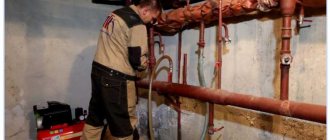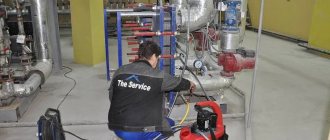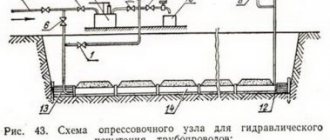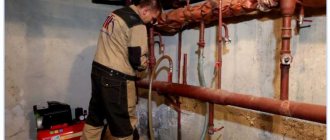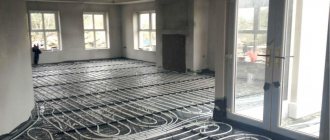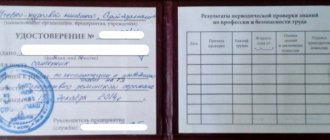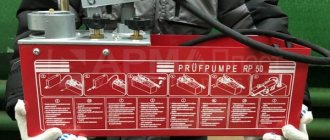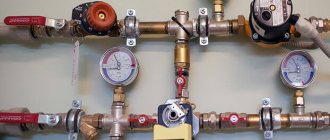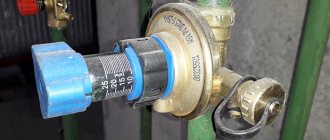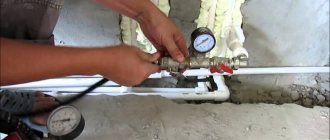There is a certain sequence when carrying out pressure testing in a heating system and when carrying out work in “old” heating systems it is very difficult to completely ensure tightness. A slight drop in pressure will definitely occur, and this is considered normal.
What pressure drop is acceptable?
The permissible pressure drop is specified in SNiP for pressure testing, namely:
1. When conducting hydraulic tests of heating systems with steel or panel radiators, a pressure drop is allowed for 15 minutes, the value of which does not exceed 0.01 MPa (0.1 kgf/cm2 or 0.1 Ati).
2. When hydraulic testing hot water supply systems for 10 minutes, the drop should not exceed 0.05 MPa (0.5 kgf/cm2 or 0.5 Ati).
3. When crimping systems with plastic pipelines for 30 minutes, the drop should not exceed 0.06 MPa (0.6 kgf/cm2 or 0.6 Ati).
To avoid a drop in pressure in the system, if the valves are not held in place, they resort to certain tricks by installing plugs - pancakes between the flanges of the valve.
To put the heating into operation, it is necessary to flush and pressure test the system. After completing this procedure, a certificate is filled out confirming that the installation of the heating network was done correctly. Employees authorized to perform this work are required to complete all relevant regulations.
SNiP crimping rules
The norms for pressure testing of the heating system are described in documents such as SNiP 41–01-2003, and also 3.05.01–85.
Air conditioning, ventilation and heating - SNiP 41-01-2003
Hydraulic checks of water heating systems can only be carried out at above-zero temperatures in the premises of the house. In addition, they must withstand water pressure of at least 0.6 MPa without damage to the seal and destruction.
During the test, the pressure value should not exceed the limit for the heating devices, pipelines and fittings installed in the system.
Internal sanitary systems - 3.05.01–85
According to this SNiP rule, it is necessary to check water heat supply and heating systems with the expansion vessels and boilers turned off using hydrostatic pressure equal to 1.5 working pressure, but not less than 0.2 MPa in the lower part of the system.
The heating network is considered to have passed the test if it holds the test pressure for 5 minutes and does not drop by more than 0.02 MPa. In addition, there should be no leaks in heating equipment, welds, fittings, threaded connections and pipes.
Features of hydraulic testing of water supply
Testing of plumbing systems is carried out before final finishing work is completed. Before the final stage of testing, all underground lines are closed, but plumbing fixtures are not yet installed. The exit points are closed with plugs.
Testing of water supply lines made of plastic is allowed to be carried out after 24 hours from the completion of installation work at temperatures above zero. To test spillways, pipes are filled with liquid to the top of the risers. If, when the spillways are completely filled, no leaks are observed for 20 minutes, and the water level does not change, then the water supply system is considered to have passed the test.
Conditions for performing crimping
Test work is carried out correctly if all necessary requirements have been met. For example, outside work cannot be carried out on the tested object, and the testing must be supervised by the shift supervisor.
Pressure testing is carried out only according to a program approved by the company’s chief engineer. It defines: the procedure for employees and the technological sequence of verification . They also outline safety measures for ongoing and current work performed at adjacent facilities.
There should be no strangers during pressure testing of the heating system; there should be no turning on or off of testing devices; only employees taking part in the test remain on site.
When work is carried out in adjacent areas, it is imperative to provide reliable fencing and turn off the testing equipment.
Inspection of heating appliances and pipes is permitted only at operating pressure values. When the heating system is pressure tested, reports are filled out to confirm the tightness.
Rules for pressure testing of a gas pipeline
Pressure testing of a gas pipe is one of the important stages of checking a pipeline before putting it into operation.
Thanks to this procedure, the tightness of the communication is determined.
Pressure testing of the gas pipeline is carried out immediately before putting it into operation and during routine checks of the gas system.
The necessity of pressure testing before starting the commissioning work is explained by the fact that it helps to identify spark plugs in welds and other defects that can cause depressurization of the pipe in the future. If any have occurred, the selection committee must issue an order to eliminate the identified problems. And only after all the regulated work is completed, the gas facility is launched.
Pressure testing of a gas pipeline
Preparatory work before crimping
The actions that must be performed before starting control pressure testing of a gas pipe are carried out in accordance with labor protection instructions developed according to standard safety regulations when performing gas hazardous work.
Preparation includes:
Gas pipeline diagram
- reconciliation of the actual underground communication with the routing indicated on the diagrams in the project documentation;
- places for connecting the necessary plugs, instrumentation and regulators are selected;
- The connection point of the compressor unit is determined.
All those involved in this event, engineers and workers, must be re-instructed on labor protection and familiarized with the procedure for performing work.
Basic norms and rules for carrying out gas hazardous work
Pneumatic pressure testing of the gas pipeline is carried out in accordance with the regulations, which are provided for in GOST R 54983 2012.
Control pressure testing with air in the connected section of the pipe must be carried out before it is inserted into the existing gas pipeline.
Rules for carrying out gas hazardous work
A control check of the cut-in section of the pipe is usually carried out by generating an excess air pressure of 100 kPa and holding it for 60 minutes. To control the pressure indicator, a pressure gauge with an accuracy class not exceeding 0.6 must be used.
The indicator of the created excess pressure in the pipeline must remain unchanged until the end of the pressure testing procedure and remain until it is connected to the existing distribution communication.
After work on inserting a section of pipe has been carried out and a certificate of commissioning of the facility has been issued, after six months a repeated leak test must be carried out, in accordance with the requirements of the set of rules SP 62.13330.2011.
When and for which gas facilities do control pressure testing be required?
Pressure testing with air or inert gas is carried out:
- for gas control points (GRP) and gas control units (GRU) after they have been installed;
- for internal and external gas pipelines, tanks, apparatus and equipment before connecting them to existing communications;
- for pipes and gas equipment after repair or replacement.
Inert gas test diagram
When the excess air pressure in the embedded pipeline is not lower than 100 kPa, you do not need to perform control pressure testing.
Control testing with inert gas or air of external communications is carried out at a pressure of 20 kPa, although this value should not fall by more than 0.1 kPa within an hour.
This procedure should be carried out on internal gas pipes of industrial workshops, rural enterprises, public buildings and boiler houses, as well as hydraulic fracturing and gas distribution equipment and equipment, only under a pressure of 10 kPa, with an allowable loss per hour of 0.6 kPa.
A control test with air under pressure of 30 kPa for 60 minutes should be carried out for containers with liquefied gas. The serviceability test is considered passed if the pressure readings on the pressure gauges have not decreased.
Classification of gas pipelines by pressure
Work execution algorithm
Inspection and control pressure testing with air or inert gas are mandatory measures for all gas pipelines.
The procedure for performing work on pneumatic testing of the pipeline.
The section of the gas pipeline subject to testing and inspection is disconnected:
Pneumatic pipeline testing
- the high pressure valve is closed;
- the valve of the low pressure pipeline is tightened;
- appropriate plugs are installed.
To avoid possible rupture of the flange connection, shunt jumpers are installed.
The gas is released through a rubberized hose or a candle, which can be installed on the riser of the condensate collector, to a place where, if possible, it can be safely disposed of at a distance of no closer than 10 meters from the point of release of the gas mixture.
After purging the pipe, devices are installed to fix the pressure gauge and compressor station.
If the pipe section is small, a hand pump is used. The gas pipeline is checked for leaks.
The required air pressure is ensured using a purge pipe.
Results of control pressure testing of the gas pipeline
The positive result of the work performed is stable pressure in the gas communication section. In this case, the repair team must remove the hoses connecting the air duct to the gas pipeline.
During these actions, you need to ensure that all shut-off valves on the air supply to the gas pipeline are closed. Next, plugs are installed on the pipes supplying air to the gas pipeline.
Removing the plugs
In the event of a drop in pressure in the communication during pneumatic testing, the result will be negative, and the launch of the gas pipeline will be postponed until appropriate measures are taken. A subsequent inspection of the test area will be required to identify inconsistencies with their further elimination. Then, the gas pipeline must be re-checked.
The results of the work performed are entered into a special journal and recorded in the work crew’s orders. There must be air pressure remaining in the system before it can be started.
The launch of a gas pipeline and other gas facilities is permitted only after successful completion of the necessary tests and execution of work completion certificates.
At enterprises with gas supply, in addition to the acceptance certificate for gas facilities, the following documents must be available:
- order appointing someone responsible for the organization's gas facilities;
- instructions for the operation of communications, equipment and equipment of the gas facilities of the organization;
- instructions for labor protection during operation and repair work on gas pipelines and gas equipment.
Results of control pressure testing of the gas pipeline
In what cases is gas release prohibited?
Starting gas is prohibited in the following cases:
Gas start ban
- a visual inspection revealed defects in pipes and equipment;
- the actual laying of the pipeline does not correspond to the routing provided for by the project;
- the gas pipeline has not passed the control pneumatic pressure testing or the results of the test are unsatisfactory;
- There are no qualified specialists and performers with the necessary approvals and permits to carry out gas hazardous work.
Basic safety provisions when introducing gas into the system
Gas start-up process
The gas start-up process must be performed at low flow rates. The feed speed should be in the range of 15–25 m/s.
This is necessary to prevent an explosion of the gas-air mixture from the possible formation of sparks when metal objects rub against the inner surface of gas pipelines.
The pressure during the filling process should not exceed 0.1 MPa.
All workers involved in gas-hazardous work are required to wear protective tarpaulin suits, helmets and rubber dielectric shoes, and also carry insulating gas masks, safety glasses and special gloves. In addition, the work team must have a first aid kit equipped with all the necessary medications to provide first aid.
Crimping procedure
This method of checking the heating system involves performing hydraulic tests:
- Heat exchangers;
- Boilers;
- Pipe
This makes it possible to identify leaks that indicate depressurization of the network.
Before testing the heating system with plugs, you should isolate the heating system from the water supply, visually assess the reliability of all connections , and also check the functionality and condition of the shut-off valves.
After this, the expansion tank and boiler are turned off to flush the radiators and pipelines from various deposits, debris and dust.
During the hydraulic test, the heating system is filled with water, but during air tests this is not done, but simply a compressor is connected to the drain valve. Then the pressure is increased to the required value, and its indicators are monitored with a pressure gauge. If there are no changes, then the tightness is good, therefore the system can be put into operation.
When the pressure begins to decrease beyond the permissible value, it means that defects are present . Leaks in a filled system are not difficult to find. But in order to identify damage during an air test, a soap solution should be applied to all joints and joints.
Air pressure testing takes at least 20 hours, and hydraulic testing takes 1 hour.
Having corrected the identified defects, the procedure is repeated again, and this must be done until good tightness is achieved . After carrying out this work, pressure testing certificates for heating systems are filled out.
Checking the heating network with air is usually carried out if it is impossible to fill it with water, or when working in low temperature conditions, because the liquid can simply freeze.
Rules for crimping heating networks - PPE, standards, instructions
To put the heating into operation, it is necessary to flush and pressure test the system. After completing this procedure, a certificate is filled out confirming that the installation of the heating network was done correctly. Employees authorized to perform this work are required to complete all relevant regulations.
Pressure testing of a heating system in a house according to SNiP: how to check the tightness of pipes and connecting units
To increase the reliability of the functioning of heating systems during their maintenance, periodic checks of the tightness of pipelines are carried out. It allows you to identify connecting elements that have become unusable.
It is also known that the vulnerability of any such system is determined by its weakest link, in the event of a malfunction of which it loses its functionality partially or completely.
To identify potentially dangerous places, a special procedure is provided, called pressure testing of heating equipment.
Heating system pressure test certificate
This document displays the following information:
- What type of crimping method was used?
- The project in accordance with which the circuit was installed;
- The date of the inspection, the address where it was carried out, as well as the names of the citizens who sign the act. This is mainly the owner of the house, representatives of the repair and maintenance organization and heating networks;
- How the identified faults were eliminated;
- Test results;
- Are there any signs of leakage or reliability of threaded and welded connections? In addition, it is indicated whether there are drops on the surface of the fittings and pipes.
Permissible test pressure when testing water heating
Many developers are interested in what pressure should be used to check the heating system. In accordance with the SNiP requirements presented above, during pressure testing, pressure is allowed to be 1.5 times higher than the working pressure , but it should not be less than 0.6 MPa.
There is another figure indicated in the “Rules for the technical operation of thermal power plants.” Of course, this method is “softer”; its pressure exceeds the working pressure by 1.25 times.
In private houses equipped with autonomous heating, it does not rise above 2 atmospheres, and it is adjusted artificially: if excess pressure appears , the relief valve immediately turns on. Whereas in public and multi-apartment buildings the working pressure is much higher than these values: five-story buildings - about 3-6 atmospheres, and tall buildings - about 7-10.
Heating system testing equipment
Most often, a pressure tester is used to perform a hydraulic test. It is connected to the circuit to regulate the pressure in the pipes.
A huge number of local heating networks in private buildings do not require high pressure, so a manual pressure tester will be sufficient . In other cases, it is better to use an electric pump.
Hand-held devices for testing heating systems develop a force of up to 60 bar or more. Moreover, this is enough to check the integrity of the system even in a five-story building.
The main advantages of hand pumps:
- Reasonable cost, which makes them accessible to many consumers;
- Light weight and dimensions of hand presses. Such devices are convenient to use not only for personal purposes, but also for professional use;
- Long service life without failures or breakdowns. The device is so simply designed that there is nothing to break in it;
- Suitable for medium and small heating equipment.
Branched and large circuits on large areas, multi-story buildings and production facilities are checked only with electrical devices. They are capable of pumping water under very high pressure , which is unattainable for manual devices. They are equipped with a self-priming pump.
Electric pumps develop a force of up to 500 bar. These units are usually built into the main line or connected to any opening. Basically, the hose is connected to a tap through which the pipe is filled with coolant.
Performing heating pressure testing is a very complex technological procedure. That’s why you shouldn’t do it yourself; it’s better to use the services of professional teams.
- Author: Vadim Nikolaevich Lozinsky
(2 votes, average: 5 out of 5)
High-quality operation of heating systems with high levels of energy efficiency and the reliability of this work depend not only on competent design and high-quality installation work, but also on carefully carried out commissioning: pressure testing and washing.
What pressure is the heating system tested at?
To put the heating into operation, it is necessary to flush and pressure test the system. After completing this procedure, a certificate is filled out confirming that the installation of the heating network was done correctly. Employees authorized to perform this work are required to complete all relevant regulations.
Pressure testing of heating systems
High-quality operation of heating systems with high levels of energy efficiency and the reliability of this work depend not only on competent design and high-quality installation work, but also on carefully carried out commissioning: pressure testing and washing.
Why hydrotest?
As you know, the heating system is a closed circuit operating under excess pressure. Any leaks in the threaded connections of the fittings or at the connection points of radiators will lead to water leakage, flooding of premises, damage to building structures, finishing, etc.
Source: https://gscomplect.com/kakim-davleniem-ispytyvaetsya-sistema-otopleniya/
Why hydrotest?
As you know, the heating system is a closed circuit operating under excess pressure. Any leaks in the threaded connections of the fittings or at the connection points of radiators will lead to water leakage, flooding of premises, damage to building structures, finishing, etc. And since the system operates in winter under pressure and high temperatures of the coolant, accidents may also occur situations that threaten the life and health of people. The consequences of leaking heating systems can be very expensive and problematic in terms of eliminating them, especially in winter.
Therefore, hydraulic tests of heating and heat supply systems are mandatory measures both at the time of commissioning of the facility and at the stage of preparatory work before the heating season.
In some cases, the absence of an act on testing the building’s heat supply systems is a guaranteed refusal of the heat supply organization to release heat into the building before the start of the heating period. Therefore, the organization operating the building must be aware of the procedure for preparing networks and must have the appropriate qualifications to test heating systems. In addition, pressure testing of heating systems connected to the heating networks of a city or town is part of the heat supply contract.
The main preparatory work and testing of heating systems include the following activities:
- system pressure testing,
- flushing of pipelines.
Hydraulic test report: example and features of its preparation
The act is an official document that should display information about the object, the tests being carried out and the members of the commission.
Testing of pipeline networks must be carried out by the installation company. The person who is responsible for carrying out the test work must have a permit that meets the requirements of SNiP III-4-80. , a hydraulic test report must be drawn up , in which it is necessary to display:
- Name of the pipeline system;
- The name of the organization that carried out technical supervision;
- Information about the test pressure and test time;
- Information about pressure reduction;
- Monomer brand;
- Description of inconsistencies found during testing, or a note about their absence;
- Conclusions;
- Date of testing.
Standard composition of the commission:
- Representative of the installation company that laid the pipeline;
- Technical Supervision Inspector;
- Representative of the operating company.
When entering information about the pipeline, in addition to the name, you must indicate its length, diameter and material of manufacture.
If the pipeline has successfully passed the tests, the commission gives permission to put the system into operation. This permission is certified by the signatures of all members of the commission. In this case, their positions and full names must be indicated.
What is system testing?
Pressure testing of heating systems means a hydrodynamic test of the pipeline network, that is, the system is maintained under a certain excess pressure for a certain period of time.
All heating system equipment is also subject to strength testing: heat exchangers, radiators, shut-off and control valves, pumping stations and other network elements.
In addition to hydraulic tests of heating systems, all other heat supply systems are subject to annual inspection: heat input units into the building, individual heating points, heating units, heat supply systems for supply ventilation and air-thermal curtains, heating systems and underfloor heating, boiler rooms, etc.
Hydraulic testing process
After appropriate preparation and inspection of the system, test activities begin, during which:
- Hydraulic equipment is connected and pressure gauges are installed;
- The system is filled with water at least +5°C. In this case, the air vents must remain open until water appears. The appearance of liquid indicates the removal of all air from the communication. To squeeze out air as much as possible, water should be supplied at the lowest point in the system.
- While the line is being filled with liquid, connections are checked to determine leaks through leaky areas.
- The pressure increases and testing of the pipeline network begins. The hydraulic test time is at least 5 minutes.
- The pressure gradually decreases to operating parameters.
- The water is drained from the communication, after which the equipment is disconnected.
The tests are considered to have been successful if the pressure gauge readings remain unchanged and there are no leaks at the joints and joints. In case of unsatisfactory results, errors are eliminated, after which the pipeline network is retested.
Pressure indicators during strength testing are established by design documentation and, depending on the pipe material, should be equal to:
As for checking external communications, testing of pressure lines that are laid in trenches is carried out twice. Primary tests are carried out before filling and fixing the fittings, repeated tests are carried out after installing safety valves and hydrants (mounted on water pipelines).
If test activities are to be carried out at sub-zero temperatures, then care must be taken to ensure that the water in the system does not freeze, especially in the drainage channels. In such situations, a solution of calcium chloride is used, which is added to the water, or preheating.
Standards governing testing procedures
Both in design, installation, and testing work, without knowledge of the regulatory framework, it will be impossible to competently perform pressure testing of heating systems.
For example, SNiP 41-01-2003 provides basic recommendations for testing heating systems:
- the air temperature in the building must be above zero degrees;
- pressure testing should not be greater than the maximum maximum pressure of equipment and materials in the heating system;
- the pressure test pressure must be 50% greater than the operating pressure of the heating system and equipment, but the indicator should not be lower than 0.6 MPa.
SNiP 3.05.01-85 regulates:
- carry out hydraulic tests of large-scale components at the assembly site;
- if the pressure in the system drops during hydraulic tests, it is necessary to visually detect the location of the leak, eliminate the leak, and then continue testing for leaks;
- Pressure testing of pipelines with installed valves or wedge valves should be performed by turning the control knob twice;
- sectional heating devices that are not factory assembled must also be pressed on site;
- hidden wiring pipelines must be tested under high pressure before finishing work;
- insulated pipes are subject to pressure testing before applying thermal insulation;
- During testing of heat supply systems, hot water boilers and membrane tanks must be turned off;
- the system is considered operational and has passed the testing measures if the pressure test has not decreased within 30 minutes and no water leaks have been detected by the visual method;
- Testing a heating system for correct and uniform heating is called a thermal test. Such activities must be carried out for seven hours with water at a temperature of at least 60 degrees. If in the summer the heat source does not produce the pressure test temperature, then the tests are postponed until the temporary heat supply is resumed, or until it is connected to the heat source.
All hydraulic tests are recorded in the pressure test report, and tests of hidden pipelines are accompanied by a sheet for hidden work.
Preparing for hydraulic tests
Before testing begins, the system undergoes a thorough visual inspection to identify deviations from the design documentation. This allows you to understand whether the system is ready for testing. During the preparatory stage:
- Joints are inspected;
- The correct installation of the fittings is determined;
- Suspensions and supporting elements are checked;
- Locking elements are tested to determine how easily they open;
- The possibilities for removing air from the system are established.
The optimal conditions for testing are a temperature not lower than +15°C. Before checking the external pipelines, it is necessary to purge them in order to free the internal space from possible contamination.
The procedure and technological features of performing pressure testing of the heating system
Hydraulic tests of heat supply systems are usually carried out with different pressure tests depending on the purpose of the system and the type of equipment used. For example, a heat input unit into a building is pressurized with a pressure of 16 atmospheres, heat supply systems for ventilation and ITP, as well as heating systems for multi-storey buildings - with a pressure of 10 atmospheres, and heating systems for individual houses - with a pressure from 2 to 6 atm.
Heating systems of newly constructed buildings are pressed with 1.5-2 times greater pressure from the worker, and heating systems of old and dilapidated houses are pressed with lower values in the range of 1.15-1.5. In addition, when crimping systems with cast iron radiators, the pressure range should not exceed 6 atm, but with installed convectors - about 10.
Thus, when choosing pressure testing, you should carefully read the equipment data sheets. It should not be higher than the maximum pressure of the “weakest” link in the system.
First, the heating or heat supply system is filled with water. If the heating system is filled with a low-freezing coolant, then pressure testing is carried out first with water, then with a solution with additives. You should know that due to lower surface tension, coolants based on ethylene glycol or propylene glycol are more fluid than water, so in case of minor leaks on the threaded connections, sometimes they should only be tightened slightly.
When preparing a functioning heating system for the heating season, the working coolant must be drained and refilled with clean water for pressure testing. The heating system is usually filled at the lowest point of the boiler room or heating unit through a drain ball valve. In parallel with filling the heating system, air must be bleed through air vents on risers, the top points of branches or through Mayevsky taps on radiators. To prevent airing of the heating system, the system is filled only from the bottom up.
Then the system pressure is increased to the calculated one, with the pressure drop monitored by measuring pressure gauges. In parallel with pressure monitoring, a visual inspection of the entire system, pipeline assemblies, threaded connections and equipment is carried out for the formation of leaks and the appearance of drops on the seams. If condensation forms on the system after filling with water, the pipelines must be dried and then inspected further.
Heating devices and pipeline sections hidden in building structures are subject to mandatory inspection.
The heating system is kept under pressure for at least 30 minutes, and if no leaks are detected and no pressure drop is recorded, then it is considered that the system has passed pressure testing.
In some cases, the pressure drop is permissible, but within limits not exceeding 0.1 atmospheres, and provided that a visual inspection does not confirm the formation of water leaks and violations of the tightness of welded and threaded connections.
If the result of hydraulic tests is negative, repair work is carried out with further repeated pressure testing.
Upon completion of the testing work, a test certificate is drawn up in the form specified in the main regulatory documents.
Features of hydraulic sewer tests
Testing of non-pressure sewer systems is carried out after completion of waterproofing work, but before the start of interior finishing. External lines are checked before backfilling trenches. At the preliminary stage, the system is tested without wells, and then tested together with wells.
Internal polymer communications should be checked only at ambient temperatures above zero, at least 24 hours after completion of all installation work.
To test wells, they are filled with water and kept for a certain time. When the inlet and outlet openings are closed, the liquid level should remain unchanged. This indicates that there is no leak.
In the case of pressure sewer systems, tests are carried out under pressure. The test is considered successful if the inlet and outlet pressures are the same - this means there are no leaks.
When carrying out testing activities and putting the pipeline into operation, the following acts must be drawn up:
- Visual inspection of the system and all components;
- Hidden works;
- Checks for strength indicators and communication density;
- Washing operations;
- Incoming quality control;
- Compliance of the work performed with the design documentation.
Flushing heating systems
Hydropneumatic flushing of heating systems is a mandatory measure when preparing the heating system for start-up before the start of the heating season.
Water circulates through a closed circuit of the heating system during the heating period, and when heated and cooled, hardness salts are deposited. And this, together with the processes of corrosion of the internal walls of the pipes, leads to the deposition of scale on them. Scale significantly reduces the internal cross-section of pipelines, increases the hydraulic resistance of the system and reduces the heat transfer of radiators.
In high-temperature heating systems, scale leads to local overheating and further formation of fistulas. Scale deposits one millimeter thick lead to a reduction in heat transfer from the heating system by 15-20%. And on a global scale, this means colossal losses of thermal power and a significant decrease in the energy efficiency of the system with a significant increase in the cost of heating the building.
Flushing heating systems is the same necessary annual event as pressure testing, and is carried out before the start of the heating season or at the time of commissioning.
The main sign of a “clogged” heating system is an increase in coolant consumption, an increase in warm-up time, or uneven heating of the radiators. In these cases, situations often arise when the pipelines are hot, but the radiators are not yet warmed up.
The hydropneumatic method involves filling the system with clean water and connecting an air compressor to it. Excessive air pressure increases the flow rate of the coolant and creates turbulent fluid flows. These flows in places of scale deposits create vortex vibrations, as a result of which contaminant particles are torn off the surface of the walls.
When supplying high pressure air, the valve on the air bleed valves must be closed, and a check valve must be installed to protect the compressor from water entering the system.
Also, for flushing the system, there are special solutions that break down the scale deposited on the walls of pipelines and thereby reduce their hydraulic resistance.
Pressure testing (pressure testing) of heating and water supply system pipes.
Reproduction of articles, as well as their individual parts, is prohibited. We want to reserve the right to exclusive placement of this material on our website home-engineering.net. Here we share the knowledge and experience gained by our team over the years of work in the field of design and installation of engineering systems.
→Home →To the list of articles
Introduction What is crimp testing (pressure testing) of pipelines and connections Description of the general procedure for crimping pipes Uponor Methodology for PEx cross-linked polyethylene pipes. Water test Uponor method for PEx-Al-PEx metal-plastic pipes. Water test Uponor procedure for PEx and PEx-Al-PEx pipes. Air test Uponor notes for testing underfloor heating pipes (underfloor heating) Rehau method for testing heating pipes, underfloor heating and water supply HERZ recommendations (DIN 4725) for hydraulic testing of underfloor heating systems KAN method for testing heating pipes (including water underfloor heating) ) and water supply system for tightness STB 2038-2010. Methodology for testing a heating system for tightness using the hydrostatic method (pressure testing with water) STB 2038-2010. Methodology for testing a heating system for tightness using the manometric method (air pressure testing) STB 2001-2010. Methodology for testing water supply systems for tightness using the hydrostatic method (pressure testing with water) STB 2001-2010. Methodology for testing a water supply system for tightness using the manometric method (air pressure testing) Conclusion
Introduction. up
The purpose of this article is to describe the procedures for pressure testing (pressure testing) of installed pipes and connections of the heating and water supply system to check the quality of the work performed. The general principles of the hydrostatic (water pressure testing) and manometric (air pressure testing) methods are described. Specific recommendations from leading manufacturers of polymer pipelines, which are often used in the installation of heating and water supply in private homes, are considered: Uponor, Rehau, Herz, Kan. Sets out local codes and regulations regarding pressure testing.
What is pressure testing of pipelines and connections. up
After installing pipelines and connections of elements of heating and water supply systems, it is necessary to check the quality of installation work and make sure there is no damage or poorly installed elements. Such tests must be carried out before and immediately during the embedding of elements of engineering systems into the building structures (pouring floor screeds, plastering grooves, sewing niches, etc.). This procedure allows you to promptly notice and eliminate accidental damage, reducing the likelihood of the so-called manifestation. "human factor".
When carrying out the pressure testing procedure, the pressure in the elements of the house’s engineering systems (heating, water supply) is monitored, and a decrease in the test pressure indicates possible damage. After this, as a rule, it is possible to localize and eliminate the problem with minimal consequences. A self-tapping screw accidentally screwed into a pipe laid in the wall or a sharp nail on a shoe when pouring heated floor pipes, or a pipe damaged during transportation or installation can (and often does) go unnoticed if pressure testing has not been carried out. During commissioning, these damages still make themselves felt and require expensive repairs, incl. and to restore the fine finishing of the premises (replacing tiles, plastering, puttying, painting, wallpapering, etc.).
Pressure testing of pipes can be carried out either with water (the working medium - which is preferable) or, in some cases, with air. Checking pipelines with air is most often carried out when the ambient temperature drops below +5°C and there is a risk of water pipes freezing. The methods for testing heating and water supply systems with water (hydrostatic tests) and air (manometric tests) are somewhat different (see below). The test pressure should be selected based on the test medium (water or air), the operating pressure of the piping system, the pipe manufacturer's recommendations, and local codes.
Description of the general procedure for performing pressure testing of pipes. up
Pressure test methods vary slightly among different pipe and equipment manufacturers, as well as in building standards, but generally have much in common. Below we have tried to outline the most important points that you should pay attention to when performing pressure testing of heating and water supply system pipes. The following sections provide specific recommendations from various manufacturers.
General procedure for crimping:
- Pressure tests are carried out with either water (preferred) or air. After completing the last connection of pipes (pressing, soldering, etc.), it is necessary to wait a certain time before starting crimping. Pressure testing is carried out immediately before embedding pipes and permanent connections into building structural elements and throughout the entire duration of embedding work.
- The test pressure must be monitored using a test pressure gauge of suitable range. Throughout the test, visual control of the absence of leaks is also carried out, therefore all elements and sections of the systems must be accessible for visual inspection. When pressure testing with air (or inert gas), foaming compounds compatible with the material of pipes and fittings, or in the simplest case, a water-soap emulsion, are used to control air leaks.
- System elements not designed for the test pressure should be disconnected: safety valves and other fittings, boiler, boiler, expansion tanks, etc., which otherwise could be damaged by high pressure.
- It is necessary to fill the pipes with water up to the operating pressure in the system (or with air - up to pressure testing), remove air from all elements (only when pressure testing with water) and visually inspect the system elements for possible leaks. Thus, unpressed and loose connections are quickly identified.
- If there are no leaks at the previous stage, you need to increase the pressure to the test pressure (the value is determined in advance). Allow some time for the expansion of polymer pipelines, periodically increase the pressure to the test pressure, visually monitoring the system elements for leaks.
- After this, during the control period of time, measure the pressure drop using the control pressure gauge.
- The pressure test is considered successful if the pressure drop (item 6) does not exceed a certain value (usually a fraction of a bar, see below). And a visual inspection of pipes, connections and other elements will not reveal leaks.
Uponor methodology for PEx cross-linked polyethylene pipes. Water test. up
Hydraulic testing (water testing) of the Uponor PE-Xa polymer piping system can be carried out in accordance with local metal piping codes. But there is a more suitable method for crimping such systems, taking into account the fact that under pressure the plastic pipes of the Uponor PE-Xa system expand and elongate.
Hydraulic tests must be carried out before putting the system into operation and before pouring concrete into the pipes. Before testing, you should make sure that there is free access to all parts of the system and the possibility of visual inspection in order to easily identify possible leaks in the future. According to the Uponor procedure, pressing should only begin some time after the last connection has been made using Q&E (Quick-and-Easy) axial pressing, see table below.
| Ambient temperature, °C | Waiting period before hydrotesting begins |
| >+10 | 15 minutes |
| +10..+5 | 30 min |
| +5..0 | 1,5 hour |
| 0..-5 | 3 hours |
| -5..-10 | 4 hours |
| -10..-15 | 8 ocloc'k |
Time from installation of last Q&E connection to testing as a function of ambient temperature.
Test procedure:
- Fill the system with clean water, remove all air from the system through air vents.
- Set a pressure 1.5 times higher than the working pressure, but not less than 0.6 MPa (6.0 bar).
- Maintain this pressure for 30 minutes by pumping. Inspect all pipe sections and connections during this period of time.
- Then you need to quickly lower the pressure to 0.5 of the working pressure. If the pressure then rises above 0.5 of the operating pressure, the system is sealed.
- Leave the system at this pressure for another 90 minutes and check the connections. If the pressure does drop during this period of time, there is a leak in the system.
Methodology for hydraulic testing of PEx polymer pipelines (Uponor).
Uponor methodology for PEx-Al-PEx metal-plastic pipes. Water test. up
Preparation for tests. The system must be protected from freezing. Before testing, it is necessary to carry out a visual inspection of all joints and connections of the system. Pressure gauges with a graduation value of no more than 0.1 bar must be connected at the lowest point of the system. The system is filled with clean drinking water, the air should be released. All tanks, valves, fittings and equipment not intended for hydraulic testing must first be disconnected or removed. All ends of the system must be hermetically sealed with plugs, shut-off valves and other equipment. In case of a large temperature difference (more than 10 degrees) between the water and the environment, the system should be kept for 30 minutes, pumping up the pressure to the test pressure every 10 minutes, for temperature compensation (temperature equalization). Visible leaks and significant pressure drops are not allowed.
Preliminary check of press connections. To detect unpressed fittings (which may have been forgotten to press), the system is subjected to a preliminary test with a pressure of 3 bar before hydraulic testing. The duration of the test is 15 minutes. If no leaks are found, proceed to hydraulic tests.
Stage 1. Hydraulic tests should be carried out in accordance with current regulations. The system is loaded with a test pressure of 1.1 from the working pressure (relative to the lowest point of the system). For example, the maximum operating pressure is 10 bar, respectively, the test pressure is 11 bar. Next, a thorough inspection of the entire system is carried out; leaks are not allowed.
Stage 2. After 30 minutes, the pressure is reduced to 50% of the original (in our example - 5.5 bar). After which the system is left for 120 minutes, no leaks are allowed during the entire period. In this case, it must be constant on the pressure measuring device. If there is a drop in pressure, there is a leak in the system that needs to be repaired. After which the tests are repeated.
Methodology for conducting hydraulic tests of metal-polymer pipelines PEx-Al-PEx (Uponor) for an operating pressure in the system of 10 bar.
Uponor procedure for PEx and PEx-Al-PEx pipes. Air test. up
If the pipe system is to be left without water after testing (the system is not expected to be started for the next 7 days and there is no constant circulation of water) or there is a risk of freezing, it is recommended to test with compressed air or inert gas. Gauge tests are carried out in 2 stages: leak test and strength test. In both cases, the additional time required for temperature compensation (balancing the temperature of the compressed air and the environment) must be taken into account. All tanks, valves, fittings and equipment not intended for hydraulic testing must first be disconnected or removed. All ends of the system must be hermetically sealed with plugs, shut-off valves and other equipment.
- Stage. Leak test. Before starting testing, inspect all areas of the system and connections. To control, use a pressure gauge with a division value of no more than 1 mbar.
- Set the pressure to 0.15 bar using an air compressor.
- Wait 15 minutes for temperature expansion of the pipes.
- Next, you need to perform an inspection - 120 minutes for a system with a volume of up to 100 liters, for every additional 100 liters of volume add 20 minutes of inspection.
- The leak test is passed if no pressure loss is detected.
- The test pressure increases to a maximum of 3 bar (for systems with a pipe diameter of 63 mm or less) or a maximum of 1 bar (for systems with a pipe diameter of over 63 mm).
Uponor notes for testing underfloor heating pipes (underfloor heating). up
Hydraulic tests must be carried out before pouring mortar or concrete into the pipes. Before carrying out hydraulic tests, the pipe loops must be completely filled with water and the air must be displaced. Tests must be carried out both before the start of laying the screed and during its implementation. When filling with mortar, the pipes must be under a pressure of at least 0.3 MPa (3.0 bar). Pressure tests should be carried out in accordance with the procedures for Uponor PE-X flexible pipes and Uponor MLC PEx-Al-PEx multilayer pipes (see above).
- It is necessary to carry out a visual inspection of the connections and ensure that the shut-off devices in front of and behind the manifolds are closed in order to limit the test area.
- Consideration should be given to equalizing the ambient temperature and the filling water temperature during an appropriate waiting period after reaching the test pressure.
- When testing with air, sufficient time is required for the temperature of the compressed air to return to ambient temperature.
- All pressure gauges used must give reliable readings accurate to 0.1 bar (10 kPa). If there is any danger of pipes freezing, proper measures must be taken to heat the building, etc.
Rehau method for testing heating pipes, underfloor heating and water supply. up
Pipelines that are mounted but not embedded in a screed or under plaster are subject to pressure testing. A change (drop) in pressure is only an indirect confirmation of a violation of the system’s tightness.
- The tightness of the system can only be checked by visual inspection of open sections of the pipeline.
- Minor leaks can be determined solely by visual inspection (protrusion of water or use of a leak detection aerosol) during a pneumatic test.
- In this case, the maximum permissible pressure of the safety valves should not be exceeded.
- Dividing the system into smaller inspection areas improves the accuracy of inspection results.
Important information on crimping with compressed air or inert gas. Small leaks can only be detected by using leak detection aerosols (foaming agents pressurized with compressed air, followed by pressure testing with water and a visual inspection). Temperature fluctuations can adversely affect the result of the hydraulic test (pressure drop or increase). Pressurized air or inert gas are compressed gases. Therefore, the volume of the pipeline determines the readings of the pressure gauges; a large volume of pipes reduces the likelihood of detecting small leaks due to a decrease in pressure.
Carrying out pressure testing: To check the tightness of a heating system based on Rehau Rautitan equipment, it is necessary to carry out a hydraulic test in the following order.
- Dismantle (if any) safety devices, meters, etc., replace them with pipes or shut-off elements.
- Fill the heating system with filtered water and remove air.
- Connect the pressure testing unit and create test pressure in the system. The test pressure must correspond to the response pressure of the safety valve. The minimum test pressure is 1 bar.
- After 2 hours, increase the pressure to the test pressure, since a drop in pressure is possible due to stretching of the pipeline.
- Maintain test pressure in the system for at least 3 hours and observe.
- Additionally, perform a full visual inspection of the heating system and look for leaks. There should be no protrusion of water along the entire length of the system.
- If possible, immediately after pressure testing, heat the system to maximum operating temperature and perform a visual leak check again.
- When laying a screed floor, the system must be under maximum operating pressure, this will allow leaks to be detected immediately.
HERZ recommendations (DIN 4725) for hydraulic testing of underfloor heating systems. up
- Pressurized water is supplied to the pipeline and air is removed. Immediately before and after laying the screed, check the water pressure.
- The test pressure must correspond to 1.3 times the operating pressure of the equipment and may not drop by more than 0.2 bar during testing.
- The equipment must remain watertight (no water escaping).
- When laying the floor screed (seamless floor), it is necessary to reduce the pressure in the pipes to the maximum permissible operating pressure.
- A pressure supply of 6 bar for 24 hours is recommended.
KAN method for testing heating pipes (including water-heated floors) and water pipes for leaks. up
- During testing, the pipes must be open (not concreted). The pipe system is tested for leaks under pressure 1.5 times higher than the operating pressure, but not more than the permissible pressure for the weakest point of the system.
- Create test pressure in three steps with an interval of 10 minutes.
- After the last increase in pressure to the test value, within the next 30 minutes the pressure must not decrease by more than 0.6 bar.
- Over the next two hours, the pressure drop compared to the previous one should not exceed 0.2 bar.
- During testing, it is necessary to visually check the tightness of the connections.
- The concrete screed can be started after leak testing. During the grouting phase of the floor on which the pipes are laid, a pressure of at least 3 bar should be maintained in the pipes (6 bar is recommended).
In the DOWNLOADS section you can download STB 2001-2010 and STB 2038-2010. The most important points regarding pressure testing of heating and water supply systems are outlined below.
STB 2038-2010. Methodology for testing a heating system for tightness using the hydrostatic method (pressure testing with water). up
When installing pipelines that are to be hidden in building structures, a leak test should be carried out before they are embedded in the structures. Tests shall be carried out under the following conditions:
- ambient air and water temperature not lower than 5°C;
- water pressure is 1.5 times greater than the working one at the lowest point of the system, which does not exceed the test pressure specified in the passports of heating devices, fittings, metering devices and pipelines;
- testing of the heating system must be carried out when it is disconnected from boilers and expansion vessels, using steel plugs;
- testing of polymer pipelines should be carried out no earlier than 24 hours after the last adhesive joint and no earlier than 2 hours after the last welded joint.
Procedure for preparing for testing:
- the heating system is filled with water from the water supply system;
- When the system is filled with water, air is removed through the air outlets;
- By external inspection, the filled system is checked for leaks from detachable connections and for fogging of pipeline welds;
- At the lowest point of the heating system, a pressure generating device is connected, which should include a pressure gauge for measuring pressure.
Test procedure:
- An excess pressure of at least 1.0 MPa is created in the heating system for a panel heating system and floor heating at the lowest point of the system, and at least 0.20 MPa for a water heating system at its highest point.
- Testing of polymer pipelines must be carried out both preliminary and final. During preliminary testing, it is necessary to provide for an increase in water pressure to the required value for at least 30 minutes. The pipeline is considered to have passed the test if the pressure drop in it is no more than 0.06 MPa. During the final test, the pipelines are kept for 2 hours.
- Record the readings of the pressure gauge installed at the lowest point of the system and begin to measure time, monitoring the readings of the pressure gauge.
- After completing the tests, it is necessary to drain the water from the heating system.
Rules for processing test results: The heating system under test is considered to have passed the test if the resulting pressure drop value is less than the permissible value or equal to:
- 0.01MPa (0.1 bar) for panel system and floor heating for 15 minutes;
- 0.02 MPa (0.2 bar) for water and steam systems (low and high pressure) for 5 minutes;
- 0.02 MPa (0.2 bar) for polymer pipelines for 2 hours.
STB 2038-2010. Methodology for testing a heating system for tightness using the manometric method (air pressure testing). up
When installing pipelines that are to be hidden in building structures, a leak test should be carried out before they are embedded in the structures. Tests shall be carried out under the following conditions:
- ambient temperature below 5°C;
- air pressure 0.1MPa;
- testing of the heating system must be carried out when it is disconnected from boilers and expansion vessels, using steel plugs;
- testing of polymer pipelines should be carried out no earlier than 24 hours after the last adhesive joint and no earlier than 2 hours after the last welded joint.
Procedure for preparing for testing:
- At the lowest point of the heating system, a pressure generating device is connected, which should include a pressure gauge for measuring pressure.
Test procedure:
- An excess pressure of 0.1 MPa is created in the heating system.
- Record the readings of the pressure gauge installed at the lowest point of the system.
- Threaded and welded connections of pipelines are covered with soap foam. If there are gas bubbles in the soap suds, the heating system is considered leaky.
- If the pressure drops by more than 0.01 MPa, it is reduced to atmospheric pressure and the defects are eliminated.
- An excess pressure of 0.1 MPa is created again, the pressure gauge readings are recorded and the time begins to be measured.
- Monitor the readings of the pressure gauge.
Rules for processing test results: The heating system under test is considered to have passed the test if the resulting pressure drop value is less than the permissible value or equal to:
- 0.01 MPa (0.1 bar) for water and panel heating systems, floor heating, polymer pipelines, etc. for 5 minutes.
STB 2001-2010. Methodology for testing water supply systems for tightness using the hydrostatic method (pressure testing with water). up
Test conditions and preparation for them are similar to STB 2038-2001, hydrostatic method (see above).
Test procedure:
- A test excess water pressure of at least 1.5 times the excess operating pressure is created in the water supply system.
- The system is considered to have passed the test if, for at least 10 minutes under test pressure, no pressure drop of more than 0.05 MPa is detected, and no traces of water leakage are found in welds, pipes, threaded connections, or shut-off valves.
- After completing the tests, it is necessary to drain the water from the water supply system.
STB 2001-2010. Methodology for testing a water supply system for tightness using the manometric method (air pressure testing). up
Test conditions and preparation for them are similar to STB 2038-2001, manometric method (see above), except for the point:
- tests of a water supply system using polymer pipes must be carried out at an air temperature in the rooms in which the water supply system pipelines are located of at least 5°C.
Test procedure:
- It is necessary to create a test excess air pressure of 0.15 MPa in the water supply system.
- Threaded and welded connections of pipelines are covered with a foaming mass. A violation of the tightness of the water supply system is judged by the air bubbles formed in the foaming mass. If a leak in the water supply system is detected, the pressure should be reduced to atmospheric pressure and the defects eliminated.
- A test excess air pressure of 0.1 MPa is created again.
- Systems are considered to have passed the tests if, during at least 5 minutes of being under test pressure using the manometric test method, no pressure drop of more than 0.01 MPa is detected.
- After completing the tests, it is necessary to reduce the air pressure in the water supply system to atmospheric pressure.
Conclusion. up
The article collected various methods of hydraulic and pneumatic testing, according to the recommendations of pipe manufacturers and the requirements of local standards. Despite the presence of some differences in the considered methods, they all share common key points. Therefore, we have summarized the goals and principles of testing installed heating and water supply system pipes for leaks.
If you need to design and install engineering systems for your home in Minsk and the Minsk region; you want to get advice and install a heating system, water supply, sewerage, ventilation, built-in vacuum cleaner, and perform electrical work; make the necessary calculations and select equipment; or you encounter difficulties in implementing your ideas - we will be happy to help you.
Hydraulic testing services
If the heating system is installed by a contractor during the construction of a new home, then the responsibility for pressure testing of pipelines lies entirely with the contractor.
In the case when the heating system is already functioning, regardless of whether it is a residential building, a municipal institution, a shopping or office complex, pressure testing is carried out by an organization that services all systems of the building. In housing construction, the law provides for the responsibility of the management company to maintain heating systems in working order, and, consequently, to carry out measures to prepare for the heating season.
For administrative and other complexes, testing of systems is carried out either by the operating organization or by a contractor who has all the necessary permits to carry out a complex of work.
